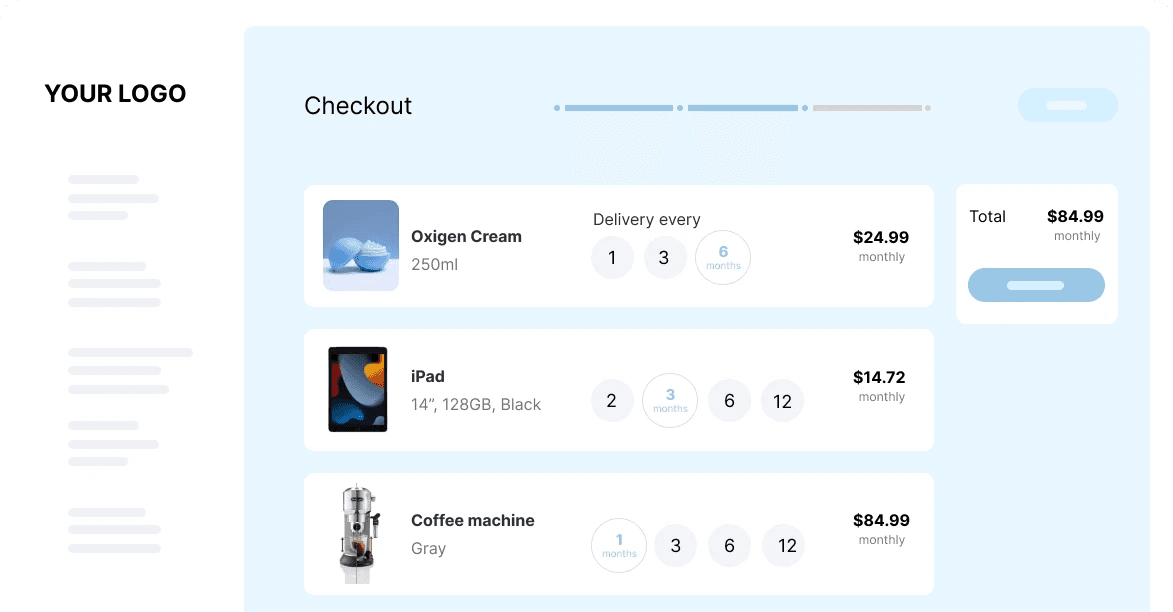
Ultimate Guide to Ecommerce Subscription Model: Expert Strategies for Predictable Growth
Patricia Bernal

Feb 25, 2025
Navigating Today's Subscription Commerce Landscape
The ecommerce subscription model has changed how businesses sell products and build lasting customer relationships. Instead of focusing only on one-time sales, companies now aim to create ongoing value and connections with their customers. This approach helps businesses better predict demand, manage stock levels, and develop a dedicated customer following. For companies that do it well, subscriptions lead to more reliable income and stronger business growth.
The Rise of Subscription Ecommerce
More and more customers want personalized products and services delivered on a schedule that works for them. They sign up for subscriptions that match their values, save time, or give them special perks. This shift in buying habits has created perfect conditions for subscription businesses to grow.
The numbers tell an impressive story. According to research by McKinsey, the subscription market has grown by more than 100 percent each year for the past five years. A study by Recurly looking at over 900 B2C ecommerce sites found that 68% of businesses give subscribers multiple plan options to choose from. This shows how important it is to offer different subscription choices to keep customers happy.
From Traditional Retail to Subscription Services
Regular stores are catching on to the benefits of subscriptions too. Many now offer both one-time purchases and subscription options to their customers. This mix gives them steady subscription income while still serving customers who prefer to buy things as needed. By testing different subscription plans, these businesses can find what works best for their specific customers.
Examples of Thriving Subscription Businesses
Many different types of companies have found success with subscriptions. Dollar Shave Club changed how people buy razors by shipping affordable blade refills straight to homes. Meal kit companies like Blue Apron and HelloFresh deliver pre-measured ingredients and recipes, making cooking easier for busy people.
The success stories span many categories - from beauty products and pet supplies to streaming services and software. This wide range shows how well subscription models can work across different industries and customer needs. It's clear evidence that more customers want ongoing relationships with brands they trust.
Understanding Your Subscription Audience

The success of any subscription ecommerce business depends on knowing your customers inside and out. This means understanding not just who they are, but what motivates them to subscribe and stay subscribed. When you truly know your audience, you can create subscription offerings that both attract new customers and keep existing ones coming back.
Identifying Key Customer Segments
Smart subscription businesses group their customers based on common traits and needs. A meal delivery service, for example, might have different plans for:
Singles living alone
Families with kids
People following specific diets (keto, vegetarian, etc.)
Budget-conscious subscribers
Premium subscribers who want organic options
This focused approach helps ensure each group gets exactly what they need.
Understanding Customer Motivations
People subscribe to services for different reasons. Some want to save time by automating regular purchases. Others love getting exclusive products or early access to sales. Many appreciate the cost savings that come with subscription pricing, especially for items they buy regularly. The key is figuring out what matters most to your specific customer base.
Analyzing Subscription Behaviors
Looking at data about how customers use your service reveals important patterns. You can see which products they love, when they tend to cancel, and what keeps them engaged. Recent studies show some fascinating trends - women make up 60% of subscription customers, though men typically maintain 3 or more active subscriptions at once. Check out more stats at Invesp's subscription model analysis. These patterns show why it's crucial to understand different customer groups' unique needs.
Building Lasting Customer Relationships
The most successful subscription businesses focus on creating personal connections with customers. They do this by:
Offering customized product selections
Providing relevant recommendations
Creating exclusive content for subscribers
Maintaining clear communication
Delivering excellent customer service
When subscribers feel valued and understood, they're much more likely to stick around long-term.
Breaking Down the Subscription Advantage

Wondering why so many businesses are moving to subscription models? The benefits go way beyond just regular income. Let's look at how subscriptions can boost your business growth and success.
Predictable Revenue and Improved Cash Flow
With subscriptions, you can say goodbye to the guessing game of one-time sales. Your business gains steady, predictable income that makes planning much easier. Since customers often pay upfront for their subscription period, you'll have better cash flow to invest back into growing your business. This reliable income stream helps you make smarter decisions about expansion and improvements.
Enhanced Customer Lifetime Value
Happy subscribers stick around longer and spend more over time. When customers have an ongoing relationship with your brand, their total lifetime value grows significantly compared to one-time buyers. Plus, satisfied subscribers often upgrade their plans and recommend your service to others, reducing what you spend on finding new customers.
Stronger Business Valuations
Investors love subscription businesses because they provide stable recurring revenue. The data proves it - according to Zuora's Subscription Economy Index, subscription companies have grown 3.4 times faster than S&P 500 companies over 12 years. While S&P companies saw 4.8% growth, subscription businesses achieved an impressive 16.5% CAGR. Check out more subscription stats here.
Scalability and Operational Efficiency
Once you set up your subscription system, growing becomes much simpler. Instead of constantly chasing new sales, you can focus on making your product better and keeping current subscribers happy. The ongoing customer relationship also gives you valuable data about what your subscribers want and need. Want to optimize your pricing? Learn more in this guide: How to master your subscription pricing strategy. Using subscriber insights helps you make smart choices to boost profitability and satisfaction.
Capitalizing on Future Subscription Trends
Success in subscription ecommerce requires staying informed about new developments and adjusting your approach accordingly. Let's explore key areas that will shape the future of subscriptions.
Leveraging Emerging Technologies
Smart technology is reshaping how subscription businesses serve their customers. AI-powered systems now create personalized boxes and product suggestions based on each subscriber's preferences and behaviors. This personal touch helps keep customers happy and subscribed longer.
Blockchain solutions are also making an impact by enabling more secure transactions and improved loyalty programs. These advances build trust between businesses and subscribers while making the entire subscription process more transparent.
Adapting to Changing Consumer Preferences
Today's subscribers want more control and value from their subscription services. The most successful companies offer:
Flexible subscription options that subscribers can easily modify
Simple cancellation processes without hidden barriers
Special member benefits that reward ongoing loyalty
Understanding what your specific audience wants and regularly updating your offerings to match their needs is essential for long-term success.
Embracing New Business Models
Fresh approaches to subscriptions are gaining popularity and creating new opportunities. Subscription rental services let customers access products without ownership, while highly personalized experiences deliver uniquely tailored value to each subscriber.
The subscription market shows strong momentum, projected to reach USD 6,369.9 billion by 2033 with a CAGR of 41.38% from 2025 to 2033. Key growth drivers include gift subscriptions, better technology, and streaming services, according to research from IMARC Group. Companies that stay flexible and experiment with emerging models are best positioned to capture this expanding market.
Building Your Subscription Success Blueprint

Success with an ecommerce subscription business comes down to smart strategy and solid execution. Let's look at the key steps to get your subscription offering up and running.
Defining Your Value Proposition
What specific benefits will your subscription bring to customers? Maybe it's saving them time, money, or giving them access to exclusive products. A meal delivery service could highlight how it helps busy families eat better. A beauty subscription might focus on letting customers discover new premium products each month. You need crystal clear benefits that connect with your target audience. Learn more about subscription impact in Subscriptions - A Game Changer in Consumer Behavior.
Designing the Customer Experience
Make every step easy - from signing up to managing subscriptions. Keep the checkout simple, offer flexible options, and provide quick support when needed. Small touches like personalized product picks or custom box contents can make subscribers feel special. Focus on removing any hassles that could frustrate customers.
Optimizing Your Subscription Funnel
Think about attracting, converting and keeping subscribers as distinct steps. Target your ideal customers with focused ads. Make sign-up quick and simple. Give members special perks to encourage them to stay. Pay attention to what's working at each stage and keep improving.
Building Scalable Operations
Plan ahead for growth in your subscriber base. Choose a reliable ecommerce platform and integrate with shipping partners who can handle increasing order volumes. Set up systems and processes that can expand smoothly as you add more customers. Having the right operational foundation is key.
Testing and Iterating
Stay flexible and keep testing different approaches. Try various pricing models, product mixes, and marketing messages. Watch important numbers like customer churn, average order size, and lifetime value. Use what you learn to make your subscription business better over time. Success comes through constant small improvements.
Mastering Subscription Metrics and Optimization

Running a successful ecommerce subscription business comes down to measuring and improving the right metrics. By tracking key performance indicators, you can make smart decisions about your subscription program and find ways to keep customers happy while growing sustainably.
Key Performance Indicators (KPIs) for Subscription Businesses
Here are the most important metrics to track for your subscription business:
Customer Churn Rate: This shows what percentage of subscribers cancel each month. High churn usually means customers aren't satisfied or don't see enough value. Since keeping existing subscribers costs much less than finding new ones, this is your most critical metric to watch. Learn more about reducing churn in our guide: How to master increasing your customer retention.
Monthly Recurring Revenue (MRR): This is the predictable monthly income from all your active subscriptions. Strong MRR growth shows your subscription business is healthy and expanding.
Average Revenue Per User (ARPU): Calculate how much revenue you earn monthly from each subscriber. You can increase ARPU by offering premium upgrades or relevant add-on products.
Customer Lifetime Value (CLTV): This estimates how much total revenue you'll earn from each customer relationship. Focus on extending subscription length and encouraging upgrades to maximize CLTV.
Using Data to Improve Your Subscription Model
Regular analysis of these KPIs helps spot opportunities:
Reducing Churn: When churn is high, look at improving product quality, adding more value, and fixing customer pain points.
Growing ARPU: Test premium tiers, complementary products, and personalized recommendations to increase average customer spend.
Boosting CLTV: Optimize customer onboarding, provide great support, and reward long-term loyalty to extend customer relationships.
Practical Tools and Techniques
Here are some helpful tools for managing subscriptions:
Forecasting Tools: Project future revenue using historical patterns to guide planning.
Reporting Dashboards: Get a quick visual overview of key metrics to spot issues early.
A/B Testing: Try different offers, prices and messaging to find what works best.
Focus on these core metrics and use the right tools to steadily improve your subscription business. Sharpei provides flexible payment options, including subscriptions, to help merchants grow. Visit our site to learn how we can help your subscription business thrive.
Related posts
Ready To Join The Circular Movement?
United for a smarter shopping experience and a better planet












